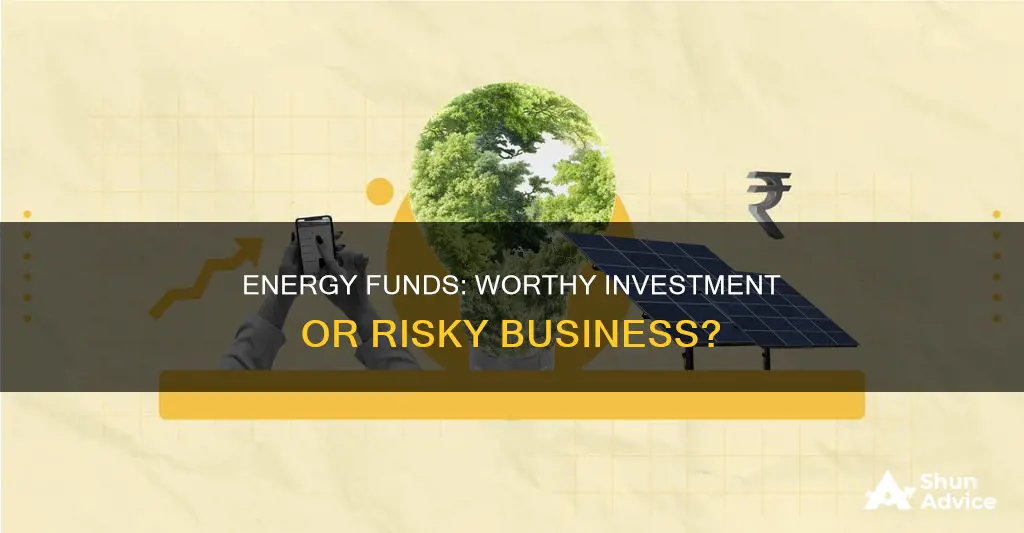
Energy funds are a hot topic, but are they a good investment? Energy stocks can be volatile, and investing in individual stocks can be challenging as you need to understand industry dynamics and each company's specific exposure. However, energy funds can provide a diversified wager, reducing risk. The big picture is crucial when considering renewable energy stocks, and while some renewable energy stocks have underperformed this year, the sector has vast potential and is expected to keep growing. Mutual funds and exchange-traded funds (ETFs) offer diversification and lower fees, making them a popular choice for long-term investors. Ultimately, the choice of investment depends on an individual's risk tolerance and objectives.
What You'll Learn

The pros and cons of investing in renewable energy
Pros:
- Renewable energy sources won't run out, unlike fossil fuels.
- Renewable energy systems have lower maintenance requirements than traditional fuel sources.
- Using renewable energy can save money in the long term, due to reduced maintenance and operating costs.
- Renewable energy sources have numerous environmental benefits, such as lower greenhouse gas emissions, cleaner water and air, and reduced waste.
- Investing in renewable energy can lead to energy independence and self-reliance.
- Renewable energy creates jobs and contributes to economic growth.
- Renewable energy is becoming more affordable, with the price of solar energy and panels dropping.
Cons:
- Renewable energy sources have high upfront costs.
- Renewable energy is intermittent and relies on weather conditions, such as sunlight and wind.
- Renewable energy sources have limited storage capabilities, which can be expensive.
- Renewable energy sources have geographic limitations and may not be suitable for all locations.
- Renewable energy isn't always 100% carbon-free, as the manufacturing and transportation of renewable energy infrastructure can create a carbon footprint.
- There may be barriers to entry for individual investors, such as high costs or a lack of accessible information.
Hedge Fund Managers: Why Shun Sustainable Investing?
You may want to see also

The performance of energy stocks
Energy stocks have been on a rollercoaster ride in recent years, with their performance closely linked to the direction of oil prices. After a strong start to 2024, energy stocks retreated, resulting in a year-to-date gain of less than 4%. This can be attributed to declining oil prices, which tempered investor enthusiasm in the energy sector. Despite this recent dip, it's important to consider the broader picture.
Historical Performance
Performance over the past 3-year and 5-year periods has been strong, with the energy sector soaring in 2021 and 2022, riding the wave of higher oil prices. However, this was followed by a modestly negative return in 2023. The S&P 500 Energy sector gained nearly 55% in 2021 and almost 66% in 2022 before experiencing a pullback in 2023. Through mid-September 2024, the S&P 500 Energy sector had gained 3.91% year-to-date, a significant drop from its mid-year position.
Factors Affecting Performance
- Energy Prices: Energy prices play a crucial role in driving the direction of energy stocks. When energy prices peaked in 2022 due to surging demand and supply constraints related to the Russia-Ukraine war, energy sector performance soared. However, energy prices have declined significantly since then, leading to a corresponding retreat in energy stock enthusiasm.
- Oil Refiners and Storage Companies: While oil prices significantly impact energy stocks, this is less true for oil refiners and storage and transportation companies. Their earnings are more affected by the volume and flow of energy rather than price fluctuations.
- Natural Gas Companies: About one-third of the S&P 500's energy sector comprises natural gas companies, whose pricing moves independently of oil price trends. Natural gas prices are driven more by domestic supply and demand dynamics.
- Political and Policy Factors: The distinct policy preferences of major political parties can influence the expansion of renewable energy generation. For example, the outcome of the 2024 US election may impact the near-term growth of renewable energy sources.
- Demand and Supply Fluctuations: Supply and demand dynamics can also affect energy stock performance. For instance, OPEC+'s decision to trim production levels in 2023 to boost oil prices was counterbalanced by increased US oil production, preventing a significant supply shortfall.
- Economic Growth: Slower economic growth in major energy-consuming countries like China and Japan can lead to reduced demand growth and impact energy stock performance.
- Transition to Renewable Energy: The gradual transition towards renewable energy sources, such as wind and solar power, is gaining momentum. While fossil fuels and nuclear power still dominate, renewables are slowly increasing their market share.
Best-Performing Energy Stocks
As of October 2024, some of the best-performing energy stocks include:
- Targa Resources (TRGP)
- The Williams Companies (WMB)
- Diamondback Energy (FANG)
- Marathon Petroleum (MPC)
In conclusion, the performance of energy stocks is influenced by a complex interplay of factors, including energy prices, political and economic dynamics, and the transition to renewable energy sources. While energy stocks have experienced volatility, with periods of strong performance and pullbacks, they continue to be a significant component of the global economy and offer potential investment opportunities. However, investing in individual energy stocks or the energy sector as a whole comes with risks, and it's essential for investors to carefully consider their strategies and conduct thorough research before making any investment decisions.
Maximizing Your HSA: Investing in Bogelheads for Secure Returns
You may want to see also

The volatility of energy stocks
Energy stocks are subject to high levels of volatility due to their dependence on various economic and geopolitical factors. This volatility can be observed in the fluctuations of stock prices in response to changes in oil prices, government policies, and economic conditions.
Oil Price Volatility
One of the most significant factors influencing energy stock volatility is oil price volatility. Oil prices can be unpredictable and prone to rapid changes due to various factors, such as supply and demand dynamics, geopolitical tensions, and the actions of oil-producing countries. As a result, energy stocks often experience significant fluctuations in response to shifts in oil prices. For example, during the initial pandemic period when vaccines were not yet available, the price of crude oil plunged to a negative $36.98 per barrel. However, as vaccines were rapidly developed and economies gradually reopened, oil prices recovered, with West Texas Intermediate crude reaching $123.64 per barrel on March 8, 2022.
Government Policies and Regulations
Government policies and regulations can also impact the volatility of energy stocks. For instance, the implementation of carbon taxes or subsidies for renewable energy sources can affect the profitability of energy companies and influence stock prices. Additionally, government interventions, such as production cuts or increases by oil-producing countries, can have a significant impact on oil prices and, consequently, the performance of energy stocks.
Economic Conditions and Recessions
Economic conditions and recessions play a crucial role in energy stock volatility. During periods of economic growth, energy demand and consumption tend to increase, driving up energy stock prices. On the other hand, recessions or economic downturns can lead to reduced energy demand and volatile stock prices. For example, despite robust US GDP growth, lingering potential recession concerns have contributed to volatility in energy stocks in recent years.
Investor Preferences and Market Trends
Investor preferences and market trends can also influence the volatility of energy stocks. During bull markets, investors may favor tech and other high-growth sectors, leading to underperformance in the energy sector. However, in times of economic uncertainty or market corrections, energy stocks may become more attractive due to their defensive characteristics.
Geopolitical Conflicts and Supply Chain Disruptions
Geopolitical conflicts and supply chain disruptions can further contribute to energy stock volatility. For example, conflicts in the Middle East or sanctions on oil-producing countries can disrupt supply and impact oil prices. Additionally, supply chain issues, such as those caused by the COVID-19 pandemic, can affect the production and distribution of energy, leading to volatile stock prices.
Natural Gas and Renewable Energy Sources
The shift towards renewable energy sources and the increasing use of natural gas can also impact the volatility of energy stocks. As countries and companies transition to cleaner energy alternatives, the demand for traditional energy sources may fluctuate, affecting stock prices.
In conclusion, energy stocks exhibit high levels of volatility due to their sensitivity to various economic, geopolitical, and industry-specific factors. Investors should carefully consider these factors and conduct thorough research before investing in the energy sector. Diversification across different energy subsectors and the inclusion of midstream energy players with more stable business models can help mitigate the risks associated with volatility in energy stocks.
A Guide to Investing in VC Funds in India
You may want to see also

The benefits of investing in energy mutual funds
Energy mutual funds are a type of investment fund that focuses on companies involved in the production, development, and distribution of energy. These funds pool money from multiple investors to invest in a diversified portfolio of energy stocks, bonds, and securities. While there are different types of energy funds, this response will focus on the benefits of investing in green energy mutual funds. Here are some advantages to consider:
Supporting Sustainable Practices and Environmental Impact
Green energy mutual funds focus on investing in companies within the renewable energy sector, including businesses involved in renewable power generation, manufacturing of renewable energy equipment, and related infrastructure. By investing in these funds, you can support environmentally sustainable practices and contribute to the global transition to cleaner, more sustainable energy sources. This shift helps combat climate change, reduce air pollution, and protect natural resources.
Potential for Financial Growth
The renewable energy sector has experienced rapid growth globally, driven by factors such as technological advancements, decreasing costs, and supportive government policies. With the increasing demand for renewable energy and the push towards a low-carbon economy, the green energy market is expected to continue its upward trajectory. Investing in green energy mutual funds allows you to tap into this potential growth and benefit from the financial returns.
Diversification and Risk Mitigation
Investing in green energy mutual funds offers diversification benefits by spreading your investments across multiple companies and sectors within the renewable energy space, such as solar, wind, hydro, biomass, and geothermal. This diversification reduces the risk associated with relying on a single company or technology, distributing risk and mitigating overall vulnerability in your investment portfolio.
Access to Expertise and Professional Management
Green energy mutual funds are actively managed by skilled fund managers who research and select investments based on their expertise and experience. As an investor, you can benefit from their in-depth knowledge of the sector and access to expert analysis and decision-making. Fund managers handle the complex tasks of research and portfolio management, providing oversight and helping you navigate the risks and opportunities in this dynamic sector.
Liquidity
Renewable energy mutual funds are known for their liquidity, which means that investors can buy or sell shares with relative ease. This liquidity provides investors with flexibility and the ability to enter or exit positions without significant impact on the stock price. However, it is important to note that some green energy stocks may have lower trading volumes, and thus, liquidity can vary across different funds and companies within the sector.
Bull Market Strategies: Index Funds Investing Guide
You may want to see also

The future of energy funds
The energy sector is currently undergoing a transition towards renewable sources, and this shift is expected to continue in the coming years. The big picture for renewable energy is promising, with solar and wind power generation expanding much faster than natural gas-fired generation in the US, and the use of coal continuing to decline. This trend is expected to continue, with the US Energy Information Administration forecasting a 75% growth in solar power generation and an 11% increase in wind power between 2023 and 2025.
However, there are some challenges to the widespread adoption of renewable energy. One significant hurdle is misinformation and disinformation about renewable energy, which can undermine the transition to cleaner energy sources. Additionally, cheap natural gas in the US makes it an attractive option for fueling power plants, creating competition for renewable energy projects.
Despite these challenges, the future of energy funds looks promising, particularly for those focused on renewable energy sources. The renewable energy sector has vast potential and is expected to continue growing. This growth is driven by increasing demand for data centers, as well as global efforts to address climate change and promote environmental, social, and governance (ESG) initiatives.
When considering investing in energy funds, it is important to keep in mind the risks and potential benefits. Energy stocks, particularly in the renewable energy sector, can be volatile. Additionally, it is crucial to diversify investments across different energy sources and technologies to mitigate risks associated with specific companies or industries.
For those looking to invest in renewable energy, there are a variety of options available, including mutual funds and exchange-traded funds (ETFs). ETFs are a popular choice due to their lower fees and tax efficiency. When choosing an ETF, it is important to consider the fund's assets under management (AUM) and fees.
Some specific examples of renewable energy ETFs include:
- IShares Global Clean Energy ETF (ICLN)
- SPDR S&P Clean Power ETF (CNRG)
- Global X YieldCo & Renewable Energy Income ETF (YLCO)
- Invesco WilderHill Clean Energy ETF (PBW)
- First Trust NASDAQ Clean Edge Green Energy Index Fund (QCLN)
- ALPS Clean Energy ETF (ACES)
In summary, the future of energy funds, particularly those focused on renewable energy, looks promising given the global shift towards cleaner energy sources. However, it is important for investors to carefully consider the risks and potential benefits before making any investment decisions.
Venture Fund Investment: Is It Worth the Risk?
You may want to see also
Frequently asked questions
Investing in renewable energy can help diversify your holdings. When oil and other traditional energy resources are volatile, renewable investments may act as a stabilizing force. Renewable energy is also becoming more affordable, making it more enticing to buyers and potentially to investors.
Examples of renewable energy funds include iShares Global Clean Energy ETF, SPDR S&P Clean Power ETF, and Global X YieldCo & Renewable Energy Income ETF.
Energy stocks are some of the most volatile and prone to bankruptcy. They are also subject to market risk and industry-specific risk, such as declining oil prices.







